The crown of glory is a trailing species of lily that is as beautiful as it is poisonous. Therefore, despite the impressive petals, it is considered a rather unconventional houseplant.
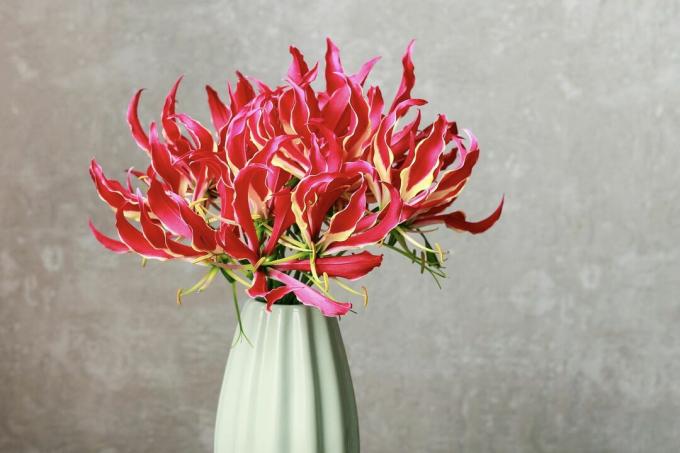
The Crown of Glory (Gloriosa superba) or called Gloriosa for short, is a poisonous pot or house plant that can also be used as a cut flower. It impresses with its flame-like, red flowers, which is why it is also called magnificent lily. It belongs to the Colchicaceae family and is related to the lantern lily, among others.
"Contents"
- Crown of glory: origin and characteristics
-
Plant Crown of Glory
- Plant Crown of Glory
- insertion of the rhizome
- Crown of Glory: location
- Maintaining the Crown of Glory
- propagation
- Winter Crown of Glory
- Is the Crown of Glory poisonous?
Crown of glory: origin and characteristics
The crown of glory comes from Africa and Asia's tropical rainforests, thickets and mountains, among others. In Europe, the crown of fame adorns apartments and gardens as a house or container plant. As a cut flower, it also comes into its own in bouquets.
The Crown of Glory lives up to its name with its flower shape resembling a flaming crown. The fiery red petals resemble licking flames and end in a yellow throat. The flowering period of the magnificent lily lasts throughout the growing season. As long as it is light, humid and warm, flowers will form. After flowering in summer, the plant retreats into the ground in autumn. At temperatures below 18 °C, nutrients and reserve substances are transferred from the above-ground plant organs to the underground storage organs, the so-called rhizomes. This is how it survives the dry season in Africa and Asia. The rhizome is frost hardy to a maximum of -9 °C. As a houseplant, temperatures below 18 °C are often not reached, so that the crown of glory remains evergreen in exceptional cases. The Gloriosa is a climbing plant and therefore needs a climbing aid or a trellis. Leaf tendrils emerge from the tips of the glossy green, entire leaves, with which it climbs to move. If there is no climbing aid, the crown of glory will continue to creep. Overall, it can reach a length of one to two meters.
Tip: The crown of glory can be used well as a cut flower. Its individual flowers are long-lasting, only the flower stalk is fragile. Therefore, it should be handled with particular care.
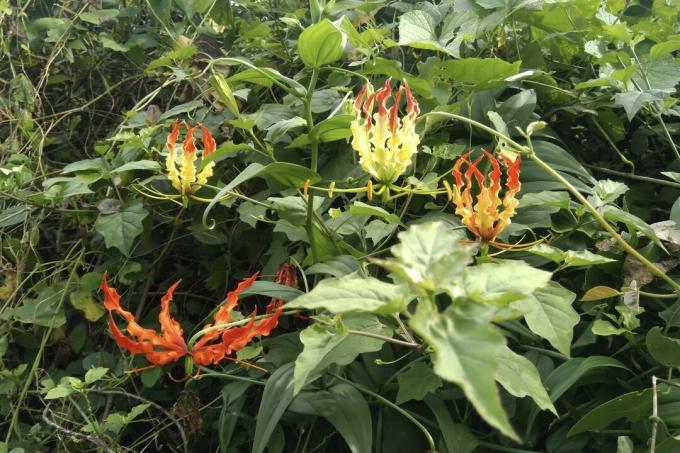
Plant Crown of Glory
Successfully cultivating the royal crown of fame is not as complex as its luxurious appearance would suggest. Here's what to look out for when planting the Crown of Glory.
Plant Crown of Glory
In order to plant the crown of glory as a houseplant or container plant, a suitable planter should first be selected. This should not be too small so that the storage organs can spread underground. The container should also have a drainage hole for irrigation water, because the magnificent lily does not tolerate waterlogging. In order to avoid waterlogging, a drainage layer should also be created so that excess water can run off better. To do this, about two to three centimeters of the vessel are filled with drainage material such as potsherds or expanded clay. The rest of the vessel is then filled with substrate. A loose, nutrient-rich garden soil, which is also water-permeable, offers optimal properties for the growth of the crown of glory. Alternatively, a suitable potting soil with the same properties can be used. A peat-free variant, such as ours, is particularly sustainable Plantura organic potting soil. This consists of purely plant-based ingredients and is therefore harmless for all pets and garden animals. The rhizome of the crown of glory can then be planted about three centimeters deep in the ground.
insertion of the rhizome
The root is inserted transversely so that the small buds point upwards. So that the buds are not damaged, the earth should only be pressed down very carefully. Large rhizomes can also be divided so that each section has at least one bud. In this way you can obtain several plants at low cost.
Important: For all gardening work with the Crown of Fame you should definitely use gloves, because the plant is highly poisonous!

Crown of Glory: location
the Gloriosa superba is cultivated in planters either only indoors or outdoors during the summer. The plant should be placed in a sunny but sheltered spot. But be careful, in direct sunlight the heat damages the leaves of the crown of glory. As an exotic plant, the crown of fame thrives particularly well at temperatures of 17 to 22 °C, which should be kept as constant as possible. In addition, she is used to a humidity of 50 to 60% in her homeland, so a place near the heating is unfavorable. A climbing aid should be used right from the start, as the shoots appear late in the year, but then grow very quickly. In order to achieve a dense growth of the trellis, the tendrils can be tied in a circle.
Tip: Are you wondering why the crown of glory is usually only sold as a rhizome and not as a plant? The rhizomes are easier to transport and store than mature plants. It also minimizes the risk of damaging the somewhat delicate Crown of Glory.
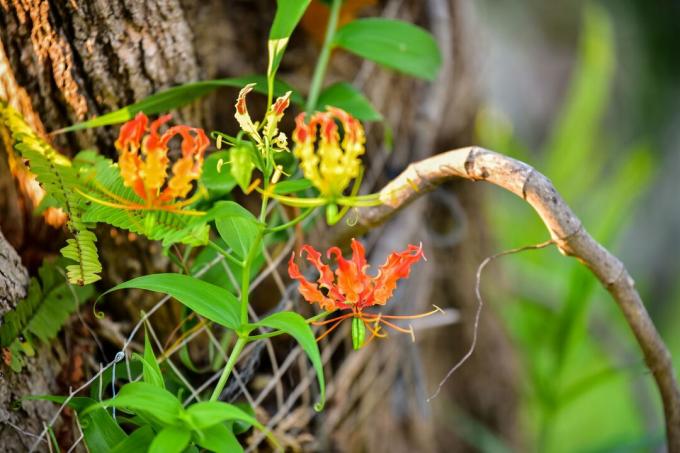
Maintaining the Crown of Glory
In order for the crown of fame to be cared for successfully, sufficient fertilization must be provided in addition to the correct watering. The Crown of Glory substrate should be moderately moist at all times and never dry or waterlogged. Ideally, the plant is watered from above twice a week, but on particularly hot weeks you should check more often to see if additional watering is needed. It is also advisable to spray the leaves and flowers with lukewarm and lime-free water on these days to increase the humidity. In addition, humidifiers can be set up in the home or greenhouse.
In order to support the growth of the crown of glory and the formation of flowers, fertilizer should be applied once a week during the growing season from March to September. The nitrogen content is particularly important for growth, which enables the crown of glory to grow rapidly. Liquid fertilizers that ensure efficient distribution of nutrients are suitable for weekly use. Our Organic flower & balcony fertilizer contains, for example, the most important nutrients in a purely organic form and is pleasantly odorless due to the absence of animal ingredients.
tip: If the plant begins to store nutrients and storage substances in the rhizome, it becomes yellow and unsightly. It should then neither be watered nor fertilized. When the Crown of Glory is completely dry, the relocation is complete. Only then should leaves and stems be removed. Affected in spring aphids gladly young shoots of the crown of glory. To avoid this, you should regularly check the shoots and undersides of the leaves of the plants. Again, make sure you wear gloves, otherwise your hands may become red. In addition, the natural enemies of the aphid can be encouraged with dead wood corners or insect hotels. If it is too humid in summer, the crown of glory is also susceptible to root rot. Therefore, you should always make sure that the potting soil is not too wet.
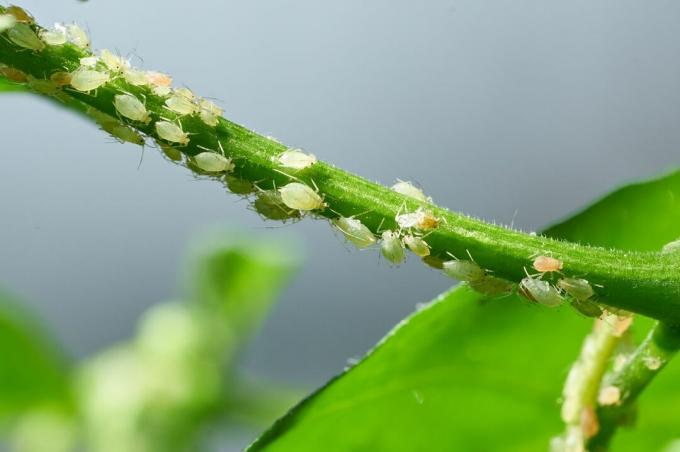
propagation
After the plant has shed its leaves, the Crown of Glory can be propagated. The rhizome is simply dug up in autumn or spring, divided with a knife and replanted as already described. Each rhizome piece should have at least one bud. Under no circumstances forget to wear gloves.
Propagation via seeds is also possible, but these have a strong germination inhibition. It can take over a year for the seed to start germinating. Therefore, this method of propagating the Crown of Glory is recommended only for patient gardeners.
Winter Crown of Glory
To overwinter the crown of glory, the root tuber can remain in the tub and placed in a place with a temperature of 10 °C. During this time neither fertilized nor watered. Shortly before new sprouting in March, the tuber needs to be repotted in fresh substrate. The rhizome is planted again at a depth of 3 cm and the plant will reappear in full splendor after 6 to 8 weeks with sufficient watering and fertilizing.
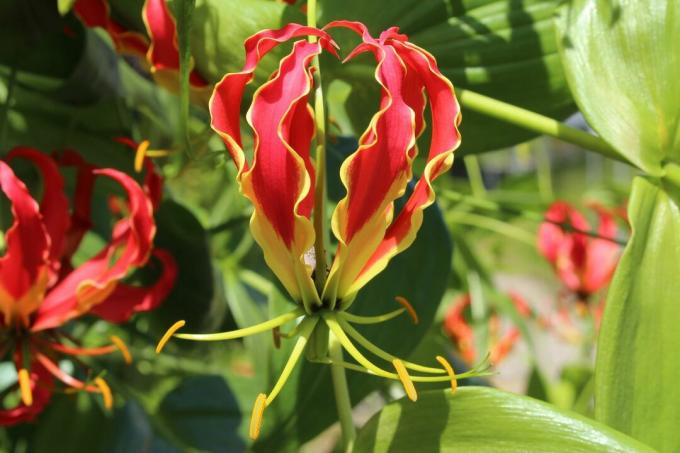
Is the Crown of Glory poisonous?
All plant parts of the Crown of Glory are highly poisonous. Its root tuber in particular contains what is known as colchicine, a poisonous alkaloid. If you experience symptoms such as difficulty swallowing, vomiting, and gastrointestinal distress, you should seek medical attention immediately. Ingestion of colchicine can be fatal.
Attention: Ingesting Crown of Glory plant parts can be deadly. It is unsuitable as a houseplant for families with children.
The autumn crocus – just like the crown of fame – belongs to the timeless family. Our article will tell you how Recognizing, planting and caring for autumn crocuses in the garden and whether these are just enchantingly beautiful or also poisonous.
